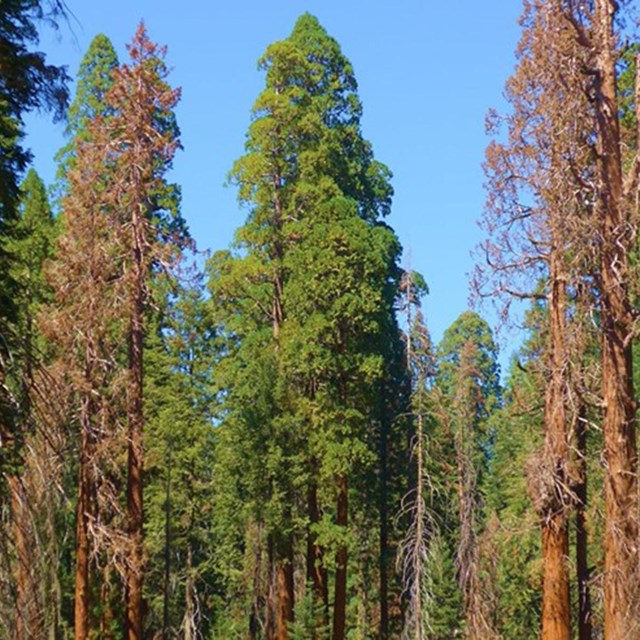
Photo by Anthony Caprio Unlike many of the cone-bearing, evergreen forests of the world, which are dominated by a single species of tree, the mixed-conifer montane forests that cloak the lower and middle slopes of the Sierra Nevada are remarkably diverse. Here ponderosa pine, incense-cedar, white fir, sugar pine, and scattered groves of giant sequoia intermix and coexist. These trees, many of which reach tremendous heights, form some of the most extensive stands of old-growth coniferous forest that remain in the world.

Photo by Linda Mutch The iconic giant sequoias grow interspersed with other trees in a mixed-conifer forest. These include white fir, sugar pine, incense-cedar, red fir, and ponderosa pine. While giant sequoias dominate in terms of size and volume, they are outnumbered by other types of trees. Giant sequoias are the world's largest trees when measured by volume, and can live to be over 3,200 years old. They have a limited distribution, reflecting climatic patterns of the past several thousand years. Once more widespread, today they occur naturally only in the Sierra Nevada. In their current range, cold temperatures may have limited their expansion into higher elevations while drought has limited grove boundaries at low elevations. Soil characteristics also are important: Giant sequoias prefer deep, sandy loam soils that are wetter, less acidic, higher in calcium, and lower in nitrogen than soils associated with neighboring conifer forests. 
NPS Photo In the upper montane, the mixed coniferous forest is replaced by nearly pure stands of red fir and lodgepole pine. Characterized by deep snow accumulation during the winter months and a dense canopy that limits the amount of sunlight that reaches the forest floor, the red fir forests lack a diverse herbaceous component. Only the most shade tolerant herbs thrive beneath the towering trees. Lodgepole pines have an unusual distribution, growing in both moist lowlands and in drier sites on benches and ridges. In wetter sites, these forests can support a rich assortment of herbs and wildflowers in their understory. 
NPS Photo - Tony Caprio Role of FireFrom fire history studies using tree-ring records, we know that mixed-conifer forests prior to 1860 burned at the following fire return intervals (time between fires):
From the late 1860s to the early 1900s, grazing and decline of Native American use of fire reduced fire frequency, followed by fire suppression that excluded fire from most of these forests. Starting in 1968, these parks began prescribed burning and allowing some lightning-caused fires to burn in remote areas.While some areas have had recent fire, many forests have not burned in decades. In the past decade, high-severity wildfires have caused extensive tree mortality in Sierran mixed-conifer forests, including killing an estimated 13-19 percent of all large giant sequoias. See the Giant Sequoias and Fire page for more information. Impacts of Climate Change on Mixed Conifer ForestsVisit the photo links below to learn more about climate change impacts on giant sequoias and other types of conifer forests. Climate Change Impacts on Forests
|
Last updated: October 16, 2023



